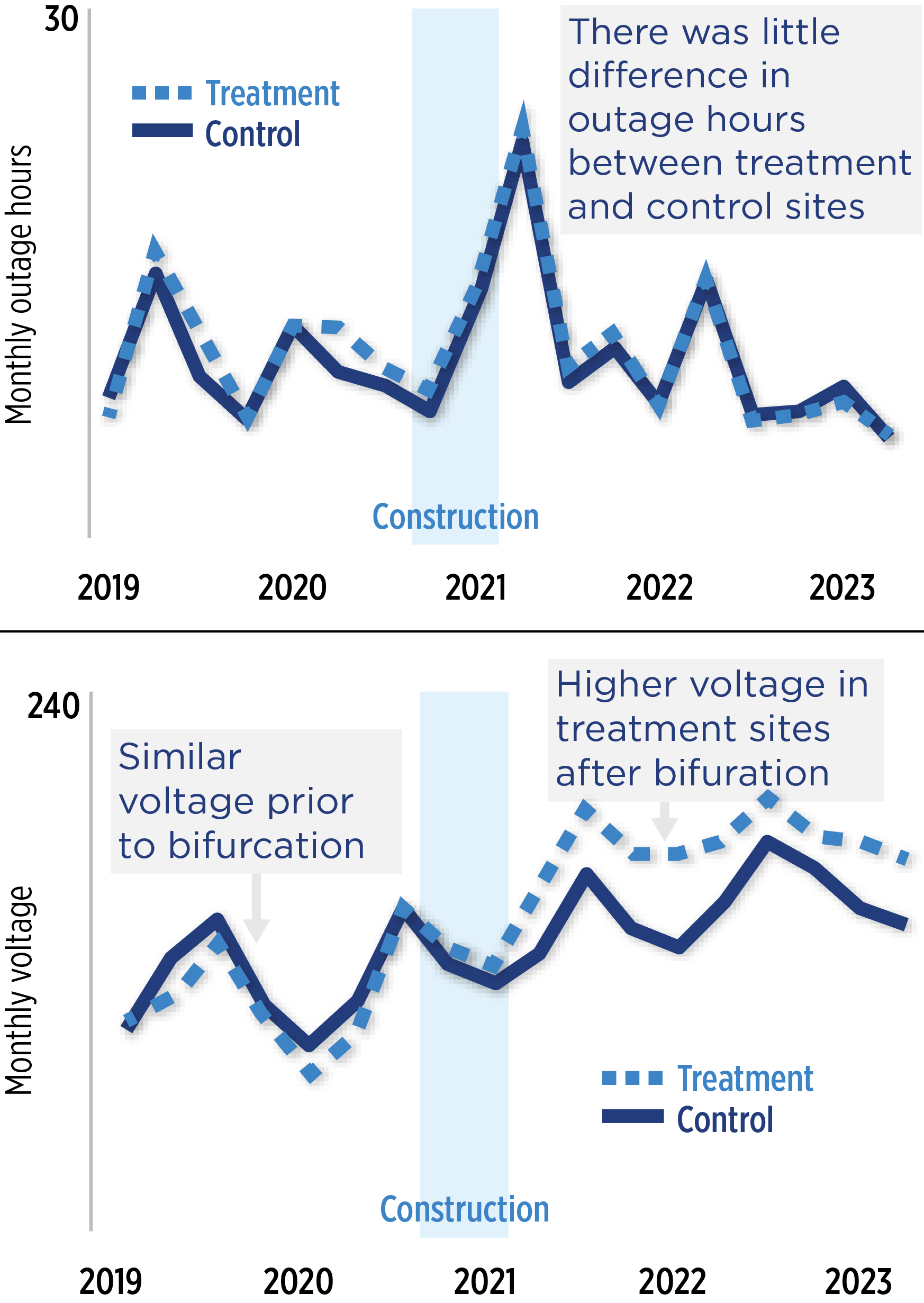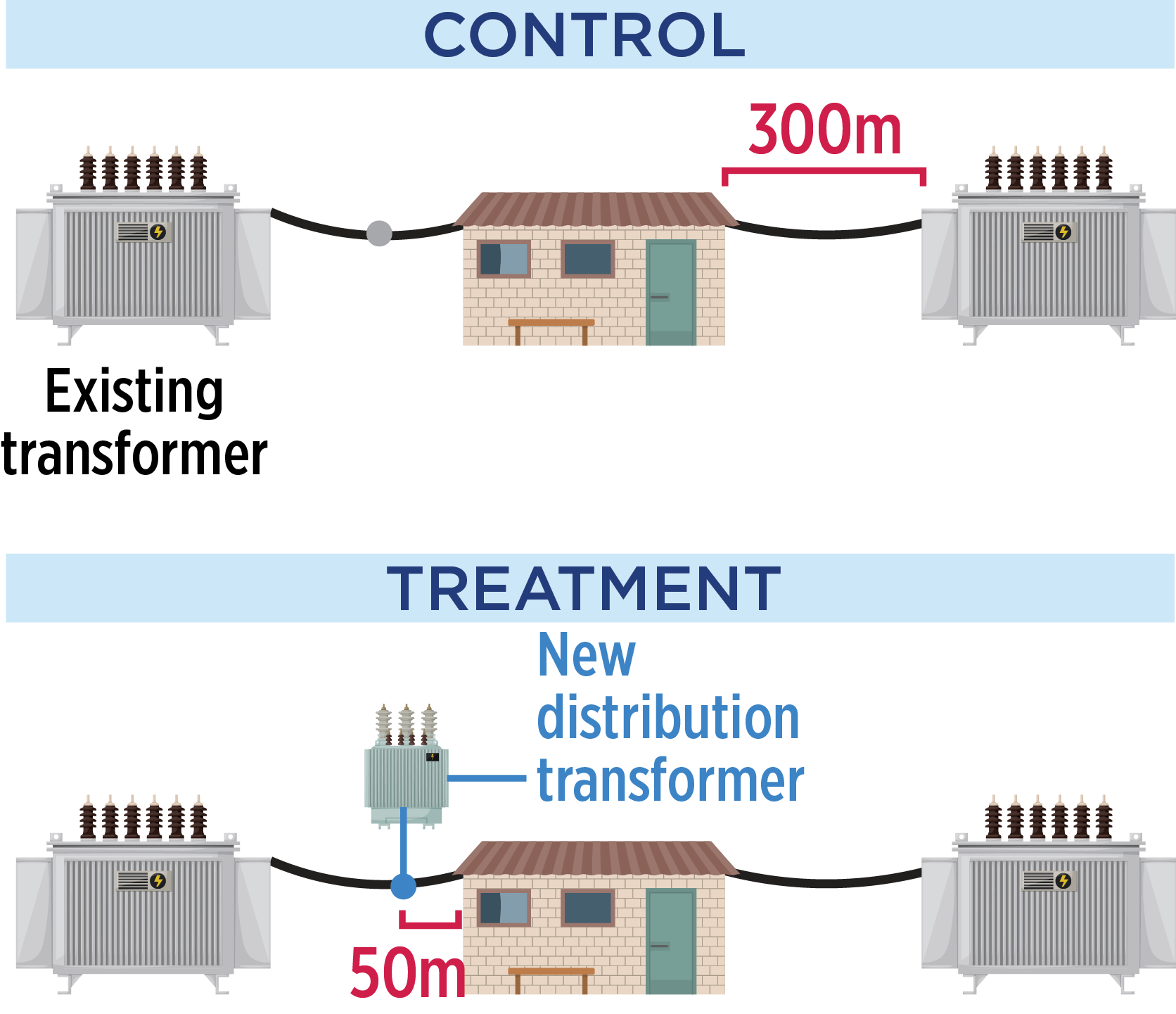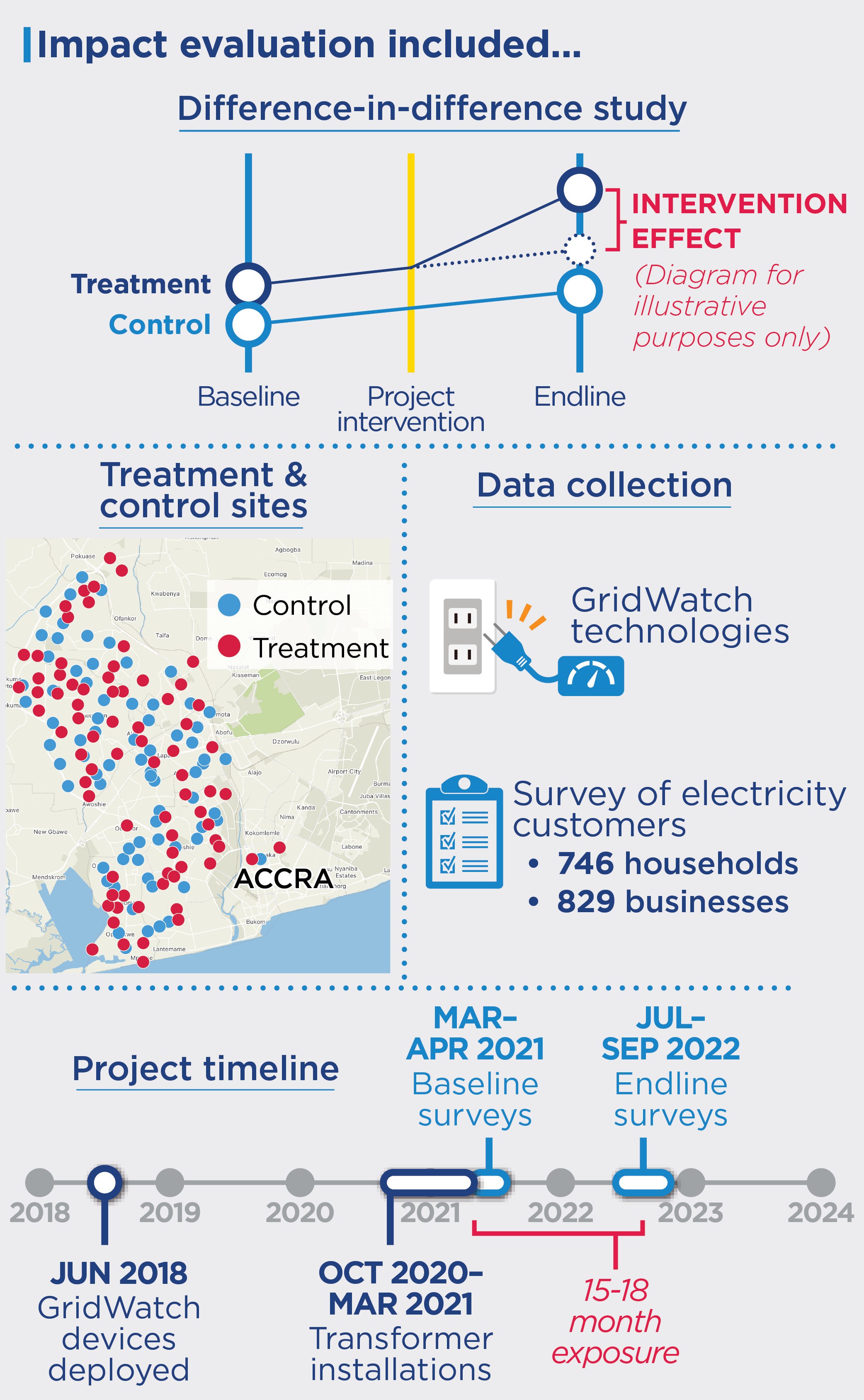Program Overview
MCC’s $311 million Ghana Power Compact (2014-2022) funded the $220 million Electricity Company of Ghana Financial and Operational Turnaround Project to improve electricity reliability. This included a $22 million investment in low voltage line bifurcation in Accra, Ghana to reduce low voltage circuit lengths by installing new transformers into the network. The theory was that this would promote economic activity and reduce the impacts of poor reliability by reducing the duration and frequency of outages, and increasing the returns from productive activities reliant on electricity.
Evaluator Description
MCC commissioned the University of California at Berkeley to conduct an independent final impact evaluation of the EFOT Project investments in low-voltage line bifurcation. Full report results and learning: https://evidence.mcc.gov/evaluations/index.php/catalog/266.
Key Findings
Power Quality and Reliability
- There was no difference in the frequency and duration of power outages in project areas that received new transformers compared to similar areas that did not receive new infrastructure.
- Average voltage increased across all areas relative to the pre-construction period and by more in project sites, reducing spells of low voltage which can damage appliances.
Customer Electricity Experience
- Customers reported significant costs related to poor power quality and were willing to pay similar amounts for improvements in voltage as for outage reductions.
- Customers reported fewer appliances damaged by voltage fluctuations and spent less on devices to protect against bad voltage in the post-construction period, but with minimal differences between project and non-project sites.
Business and Household Investment and Productivity
Evaluation Questions
This final impact evaluation was designed to answer the following questions regarding the investments in low-voltage line bifurcation under the compact:
- 1
What is the impact of these infrastructure investments on the reliability of power in areas of Accra targeted by the line bifurcation and network upgrades? - 2
What are the benefits of access to reliable power on customers, including households and businesses? - 3
What is the project’s overall impact on the profitability and productivity of enterprises?
Detailed Findings
The findings discuss changes that can be specifically attributed to transformer investments as well as more general changes over the study period. These general changes could reflect other concurrent compact investments or general improvements in electricity infrastructure as well as broader economic changes.
Power Quality and Reliability

Changes in monthly hours of outages and in average voltage levels.
Within the targeted districts of Accra, installing new distribution transformers onto low-voltage (LV) power lines reduced the distance between existing customers and the nearest transformer. This was expected to directly improve voltage quality, in addition to reducing power outages caused by overloaded transformers at the LV level. However, the evaluation found that transformer installations did not reduce outage frequency or duration, even though this was a primary objective of the overall Electricity Company of Ghana Financial and Operational Turnaround (EFOT) Project. There were no differences in outage patterns, either before or after the line bifurcation activity, between treatment sites where transformers were installed and control sites which met the criteria for a new transformer but did not ultimately receive one. This was likely because LV outages arising from overloaded transformers accounted for only a small share of total outages in the study area.
In contrast, while voltage quality was similar across sites prior to line bifurcation, it was 5 volts (V) higher at treatment sites than at control sites in the two years after line bifurcation. Average voltage measured by the GridWatch technology rose from 219V to 225V in control sites, while transformer installations in treatment sites increased average voltage by an additional 5V to Ghana’s nominal voltage of 230V. The amount of time that voltage is more than 10% below the nominal level fell from 5.2 hours per day to 3.5 in control sites and 1.6 in treatment sites, protecting customers from voltage drops that most adversely affect appliance use.
The analysis also showed that increased voltage detected at control sites was not due to spillover improvements from nearby transformer installations.
Customer Electricity Experience

In treatment sites, new distribution transformers were constructed closer to households.
At baseline, 27% of all household and business electricity customers reported that poor electricity quality imposes costs by damaging appliances, requiring spending on protective devices (26%), and limiting the use of electric appliances. By endline, households and businesses in both treatment and control areas reported similar improvements on outcomes directly related to voltage quality. All customers were 20% less likely to report an appliance being damaged by voltage fluctuations in the past year during the endline survey than at baseline. Ownership of devices to protect against voltage fluctuations fell by 8% and spending on such devices fell by 51%. Improvements across these measures were slightly larger in treatment sites. Use of alternative energy sources such as generators and gas did not change. Electricity spending fell on average, but this may be due to seasonal patterns in electricity use arising from differences in survey timing.
Businesses were also 19 percentage points less likely to say bad voltage is an obstacle to business operations compared to baseline. Overall, respondents were willing to pay similar amounts to improve voltage quality as to reduce outages: USD 1.88 and 1.64 per month, respectively, around 10% of monthly electricity spending.
Business and Household Investment and Productivity
Transformer installations did not significantly affect business profitability or productivity. There were no changes in business employment or operating hours and minimal changes in primary activities. Households in areas receiving transformer installations did not experience any benefits relative to those in control areas. The types of cooking fuels and lighting sources used did not change, nor did total household income.
Economic Rate of Return
MCC typically considers a 10% economic rate of return (ERR) as the threshold to proceed with investment.
- 19%
Original ERR - 9%
Updated ERR - Not calculated
Evaluation-based ERR
While the evaluator did not recalculate the ERR, they provided feedback on the validity of the ERR produced by MCC (9%) in light of the evaluation findings.
This evaluation reports on the line bifurcation transformer installation sub-activity of the Ghana Power Compact. MCC’s ERR assumed a 50%, or 25-hour reduction, in annual outage hours, but there were no significant impacts of this sub-activity on power outages, nor were there decreases in outages over the study period. Voltage quality did improve but economic impacts of the sub-activity were limited.
MCC Learning
Harness newer grid measurement technologies in the design, screening, and prioritization of power infrastructure projects.
Further explore the role of voltage quality in mediating consumer outcomes.
Evaluation Methods

The impact evaluation is a difference-in-differences study. It compares changes from before and after the completion of the line bifurcation transformer installation activity in 76 treatment sites that received an installation with changes in 75 comparable control sites. Differences in the changes over time in treatment sites relative to control sites are attributed to the line bifurcation investments.
The evaluation uses two main data sources. First, technical data on power reliability and quality were collected using the GridWatch suite of technologies, consisting of devices that are plugged into wall outlets within participating households and businesses. The devices are designed to detect power outages and restorations in real-time, including their precise timing and location. Three GridWatch technology devices were deployed to each study site starting in June 2018 and collected high-frequency data on site-level outages and voltage quality through April 2023.
Second, 746 household and 829 business electricity customers in the study sites were surveyed. The household surveys collected information on socioeconomic characteristics of the household, including household size and income. The business surveys collected information on business activities, revenues, and profits, as well as information on constraints firms faced and measures taken in response to electricity reliability issues. Both businesses and households reported detailed data on electricity usage, including spending, appliance ownership and use, use of electricity protection devices, and impacts of reliability issues.
Installation of transformers began in 2020 but was delayed due to Covid-19, and new transformers were commissioned in March-April 2021. Data collection for the endline survey took place in July-September 2022, for an exposure period of around 16 months.
2024-002-2961


